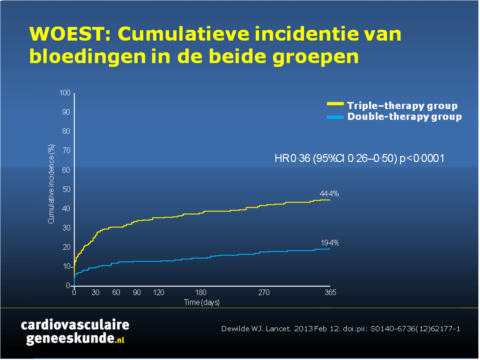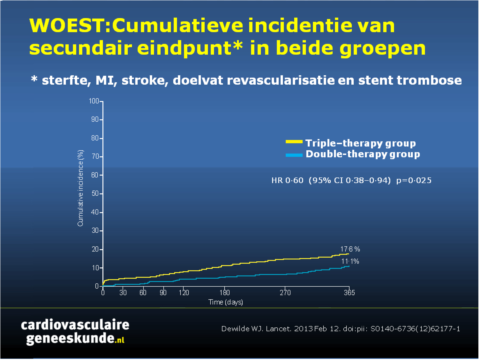WOEST: aspirine niet nodig bij PCI-patiënten met antistolling vanwege AF of kunstklep
Literatuur - DeWilde WJ et al., Lancet 12 feb 2013 - Lancet. 2013 Feb 12. doi:pii: S0140-6736(12)62177-1
Use of clopidogrel with or without aspirin in patients taking oral anticoagulant therapy and undergoing percutaneous coronary intervention: an open-label, randomised, controlled trial.
Dewilde WJ, Oirbans T, Verheugt FW, Kelder JC, De Smet BJ, Herrman JP, Adriaenssens T, Vrolix M, Heestermans AA, Vis MM, Tijsen JG, van 't Hof AW, Ten Berg JM; for the WOEST study investigators.
Lancet. 2013 Feb 12. doi:pii: S0140-6736(12)62177-1. 10.1016/S0140-6736(12)62177-1. [Epub]
Achtergrond
Levenslange antistolling is nodig voor de preventie van een beroerte bij patiënten met hartritmestoornissen en mechanische kleppen en bij de meeste patiënten met atriumfibrilleren [1-3]. Patiënten met een geïmplanteerde coronaire stent hebben ook de plaatjesremmers aspirine en clopidogrel nodig om de zeldzame, maar dodelijke complicatie stenttrombose te voorkomen [3,4]. Triple therapie met een oraal antistollingsmiddel, aspirine en clopidogrel geeft echter een toename van het risico van ernstige bloedingen en daarmee geassocieerde mortaliteit [5-8].De What is the Optimal antiplatElet and anticoagulant therapy in patients with oral anticoagulation and coronary StenTing (WOEST) studie is een investigator-driven studie ontworpen om een specifieke dilemma in de cardiologie te beantwoorden: de optimale antitrombotische behandeling van patiënten die orale anticoagulantia gebruiken (voor atriumfibrilleren of een mechanische klep) die coronaire stenting moeten ondergaan. De studie is de eerste naar de veiligheid van het weglaten van aspirine in dit soort patiënten.
De studie randomiseerde 573 patiënten naar OAC (acenocoumarol of fenprocoumon) plus alleen clopidogrel (double therapy) of OAC plus clopidogrel plus aspirine (triple therapy). Follow-up was een jaar; het primaire eindpunt was het optreden van alle bloedingen (TIMI criteria), secundaire eindpunten waren een combinative van stroke, sterfte, MI, stent trombose en target vessel revascularisatie en daarnaast alle individuele componenten van primaire en secundaire eindpunten.
Belangrijkste resultaten
- Na 1 jaar follow-up was een bloeding opgetreden in 54 (19,4%) patiënten in de dual therapy groep en in 126 patiënten (44,4%) in de triple-therapie groep (figuur 1). In de dual therapy groep hadden zes (2,2%) patiënten meerdere bloedingen, tegenover 34 (12,0%) in de triple-therapie groep.
- Na 1 jaar was ten minste één bloedtransfusie nodig in 11 (3,9%) patiënten op dual therapy, vergeleken met 27 (9,5%) van die patiënten op triple therapie (odds ratio van Kaplan-Meier-curve 0,39, 95% BI 0,17-0,84, p = 0,011).
- Het gecombineerde secundaire eindpunt van sterfte, myocardinfarct, beroerte, doelvat revascularisatie en stent trombose werd gemeld bij 31 (11,1%) patiënten in de dual therapy groep en in 50 (17.6%) in de triple-therapie groep (fig. 2). Na correctie voor onevenwichtigheid in de baseline karakteristieken bleef de HR vergelijkbaar (0,56, 95% CI 0,35 -0,91). Zeven patiënten (2,5%) in de dual therapy groep en 18 (6,3%) in de triple-therapie groep waren overleden door alle oorzaken na 1 jaar.
Conclusie
Het weglaten van aspirine bij patiënten die orale anticoagulantia gebruiken en een PCI ondergaan, leidt tot minder bloedingen, terwijl het risico op trombotische events niet wordt verhoogd.Download CVG WOEST LANCET 2013.pptx


Referenties
1. American College of Cardiology/American Heart Association Task Force on Practice Guidelines, Society of Cardiovascular Anesthesiologists, Society for Cardiovascular Angiography and Interventions, et al. ACC/AHA 2006 guidelines for the management of patients with valvular heart disease: a report of the American College of Cardiology/American Heart Association Task Force on Practice Guidelines (writing committee to revise the 1998 Guidelines for the Management of Patients With Valvular Heart Disease): developed in collaboration with the Society of Cardiovascular Anesthesiologists: endorsed by the Society for Cardiovascular Angiography and Interventions and the Society of Thoracic Surgeons. Circulation 2006; 114: e84–231.2. Camm AJ, Kirchhof P, Lip GY, et al. Guidelines for the management of atrial fibrillation: the Task Force for the Management of Atrial Fibrillation of the European Society of Cardiology (ESC). Eur Heart J 2010; 31: 2369–429.
3. Lip GY, Huber K, Andreotti F, et al. Management of antithrombotic therapy in atrial fibrillation patients presenting with acute coronary syndrome and/or undergoing percutaneous coronary intervention/ stenting. Thromb Haemost 2010; 103: 13–28.
4. Smith SC Jr, Feldman TE, Hirshfeld JW Jr, et al. ACC/AHA/SCAI 2005 guideline update for percutaneous coronary intervention—summary article: a report of the American College of Cardiology/American Heart Association Task Force on Practice Guidelines (ACC/AHA/SCAI Writing Committee to Update the 2001 Guidelines for Percutaneous Coronary Intervention). Circulation 2006; 113: 156–75.
5. Hansen ML, Sørensen R, Clausen MT, et al. Risk of bleeding with single, dual, or triple therapy with warfarin, aspirin, and clopidogrel in patients with atrial fibrillation. Arch Intern Med 2010; 170: 1433–41.
6. Karjalainen PP, Porela P, Ylitalo A, et al. Safety and efficacy of combined antiplatelet-warfarin therapy after coronary stenting. Eur Heart J 2007; 28: 726–32.
7. Orford JL, Fasseas P, Melby S, et al. Safety and efficacy of aspirin, clopidogrel, and warfarin after coronary stent placement in patient with an indication for anticoagulation. Am Heart J 2004; 147: 463–67.
8. Doyle BJ, Rihal CS, Gastineau DA, Holmes DR Jr. Bleeding, blood transfusion, and increased mortality after percutaneous coronary intervention: implications for contemporary practice. J Am Coll Cardiol 2009; 53: 2019–27.
Abstract
Background:
If percutaneous coronary intervention (PCI) is required in patients taking oral anticoagulants, antiplatelet therapy with aspirin and clopidogrel is indicated, but such triple therapy increases the risk of serious bleeding. We investigated the safety and efficacy of clopidogrel alone compared with clopidogrel plus aspirin.
Methods:
We did an open-label, multicentre, randomised, controlled trial in 15 centres in Belgium and the Netherlands. From November, 2008, to November, 2011, adults receiving oral anticoagulants and undergoing PCI were assigned clopidogrel alone (double therapy) or clopidogrel plus aspirin (triple therapy). The primary outcome was any bleeding episode within 1 year of PCI, assessed by intention to treat. This study is registered with ClinicalTrials.gov, number NCT00769938.
Findings:
573 patients were enrolled and 1-year data were available for 279 (98•2%) patients assigned double therapy and 284 (98•3%) assigned triple therapy. Mean ages were 70•3 (SD 7•0) years and 69•5 (8•0) years, respectively. Bleeding episodes were seen in 54 (19•4%) patients receiving double therapy and in 126 (44•4%) receiving triple therapy (hazard ratio [HR] 0•36, 95% CI 0•26-0•50, p<0•0001). In the double-therapy group, six (2•2%) patients had multiple bleeding events, compared with 34 (12•0%) in the triple-therapy group. 11 (3•9%) patients receiving double therapy required at least one blood transfusion, compared with 27 (9•5%) patients in the triple-therapy group (odds ratio from Kaplan-Meier curve 0•39, 95% CI 0•17-0•84, p=0•011).
Interpretation:
Use of clopiogrel without aspirin was associated with a significant reduction in bleeding complications and no increase in the rate of thrombotic events.

Deel deze pagina met collega's en vrienden: